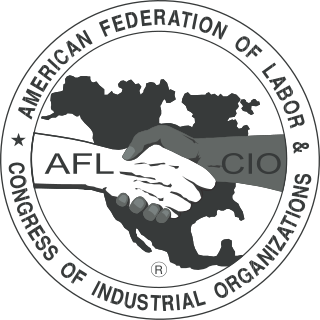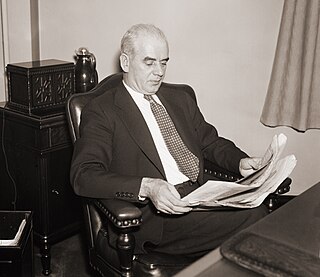
The American Federation of Labor and Congress of Industrial Organizations (AFL-CIO) is a national trade union center that is the largest federation of unions in the United States. It is made up of 60 national and international unions, together representing more than 12 million active and retired workers. The AFL-CIO engages in substantial political spending and activism, typically in support of progressive and pro-labor policies.

John Llewellyn Lewis was an American leader of organized labor who served as president of the United Mine Workers of America (UMW) from 1920 to 1960. A major player in the history of coal mining, he was the driving force behind the founding of the Congress of Industrial Organizations (CIO), which established the United Steel Workers of America and helped organize millions of other industrial workers in the 1930s, during the Great Depression. After resigning as head of the CIO in 1941, thus keeping his promise of resignation if President Franklin Delano Roosevelt won the 1940 election against Wendell Willkie, Lewis took the United Mine Workers out of the CIO in 1942 and in 1944 took the union into the American Federation of Labor (AFL).

The American Federation of Labor was a national federation of labor unions in the United States that continues today as the AFL–CIO. It was founded in Columbus, Ohio, in 1886 by an alliance of craft unions eager to provide mutual support and disappointed in the Knights of Labor. Samuel Gompers was elected the full-time president at its founding convention and was re-elected every year except one until his death in 1924. He became the major spokesperson for the union movement.

William George Meany was an American labor union leader for 57 years. He was the key figure in the creation of the AFL–CIO and served as the AFL–CIO's first president, from 1955 to 1979.

Operation Dixie was the name of the post-World War II campaign by the Congress of Industrial Organizations to unionize industry in the Southern United States, particularly the textile industry. Launched in the spring of 1946, the campaign ran in 12 Southern states and was undertaken as part of a dual effort to consolidate wage gains won by the trade union movement in the Northern United States by raising wage levels in the South while simultaneously transforming the conservative politics of the region, thereby allowing the trade union agenda to win on a national scale.
The Trades and Labor Congress of Canada was a Canada-wide central federation of trade unions from 1886 to 1956. It was founded at the initiative of the Toronto Trades and Labour Council and the Knights of Labor. It was the third attempt at a national labour federation to be formed in Canada: it succeeded the Canadian Labour Union which existed from 1873 to 1877 and the Canadian Labour Congress which held only one conference in 1881.

Matthew Woll was president of the International Photo-Engravers Union of North America from 1906 to 1929, an American Federation of Labor (AFL) vice president from 1919 to 1955 and an AFL-CIO vice president from 1955 to 1956.

The Seafarers International Union or SIU is an organization of 12 autonomous labor unions of mariners, fishermen and boatmen working aboard vessels flagged in the United States or Canada. Michael Sacco was its president from 1988 until 2023. The organization has an estimated 35,498 members and is the largest maritime labor organization in the United States. Organizers founded the union on October 14, 1938. The Seafarers International Union arose from a charter issued to the Sailors Union of the Pacific by the American Federation of Labor as a foil against loss of jobs to the Congress of Industrial Organizations (CIO) and its Communist Party-aligned faction.

The Oil, Chemical and Atomic Workers Union (OCAW) was a trade union in the United States which existed between 1917 and 1999. At the time of its dissolution and merger, the International represented 80,000 workers and was affiliated with the AFL–CIO.
The Steel Workers Organizing Committee (SWOC) was one of two precursor labor organizations to the United Steelworkers. It was formed by the CIO on June 7, 1936. It disbanded in 1942 to become the United Steel Workers of America. The Steel Labor was the official paper of SWOC.
The National Federation of Independent Unions was a group of independent labor unions not affiliated with the American Federation of Labor (AFL) or the Congress of Industrial Organizations (CIO). It included a variety of unions, including the Mechanics' Educational Society of America (MESA), the United Brotherhood of Welders, Cutters and Helpers of America, the Western Electric Independent Labor Federation, and the National Brotherhood of Packinghouse Workers. Formed in 1942, it sought to create a voice in Washington for independent unionism, particularly on the National War Labor Board (NWLB).

Florida AFL–CIO is a statewide federation of labor unions in the state of Florida affiliated with the AFL–CIO. The federation's membership consists of about 450 local unions from 41 international unions. The headquarters of the organization are located in Tallahassee, Florida.

James Barron Carey was a 20th century American labor union leader, secretary-treasurer of the Congress of Industrial Organizations, vice president of AFL–CIO and served as president of the United Electrical Workers, but broke from it because of its alleged Communist control. He was the founder and president of the rival International Union of Electrical, Radio and Machine Workers (1950–1965). President Truman appointed Carey to the President's Committee on Civil Rights in 1946. Carey was labor representative to the United Nations Association (1965–1972). He helped influence the CIO's pullout from the World Federation of Trade Unions (WFTU) and the formation of the International Confederation of Free Trade Unions (ICFTU) dedicated to promoting free trade and democratic unionism worldwide.

The Congress of Industrial Organizations (CIO) was a federation of unions that organized workers in industrial unions in the United States and Canada from 1935 to 1955. Originally created in 1935 as a committee within the American Federation of Labor (AFL) by John L. Lewis, a leader of the United Mine Workers (UMW), and called the Committee for Industrial Organization. Its name was changed in 1938 when it broke away from the AFL. It focused on organizing unskilled workers, who had been ignored by most of the AFL unions.

The 2018 United States House of Representatives elections in Texas were held on Tuesday, November 6, 2018. Voters elected the 36 U.S. representatives from the state of Texas, one from each of the state's 36 congressional districts. The elections coincided with the elections of other offices, including the gubernatorial election, as well as other elections to the House of Representatives, elections to the United States Senate and various state and local elections. The primaries were held on March 6 and the run-offs were held on May 22.
Morris Iushewits or Iushewitz was a union activist and leader of the Newspaper Guild, the Congress of Industrial Organizations (CIO), and the American Federation of Labor and Congress of Industrial Organizations (AFL–CIO).
The International Brotherhood of Pulp, Sulphite, and Paper Mill Workers (IBPSPMW) was a labor union representing workers involved in making paper in the United States and Canada.
The United Paperworkers of America (UPA) was a labor union representing workers involved in making paper in the United States.
The United Rubber, Cork, Linoleum and Plastic Workers of America (URW) was a labor union representing workers involved in manufacturing using specific materials, in the United States and Canada.














